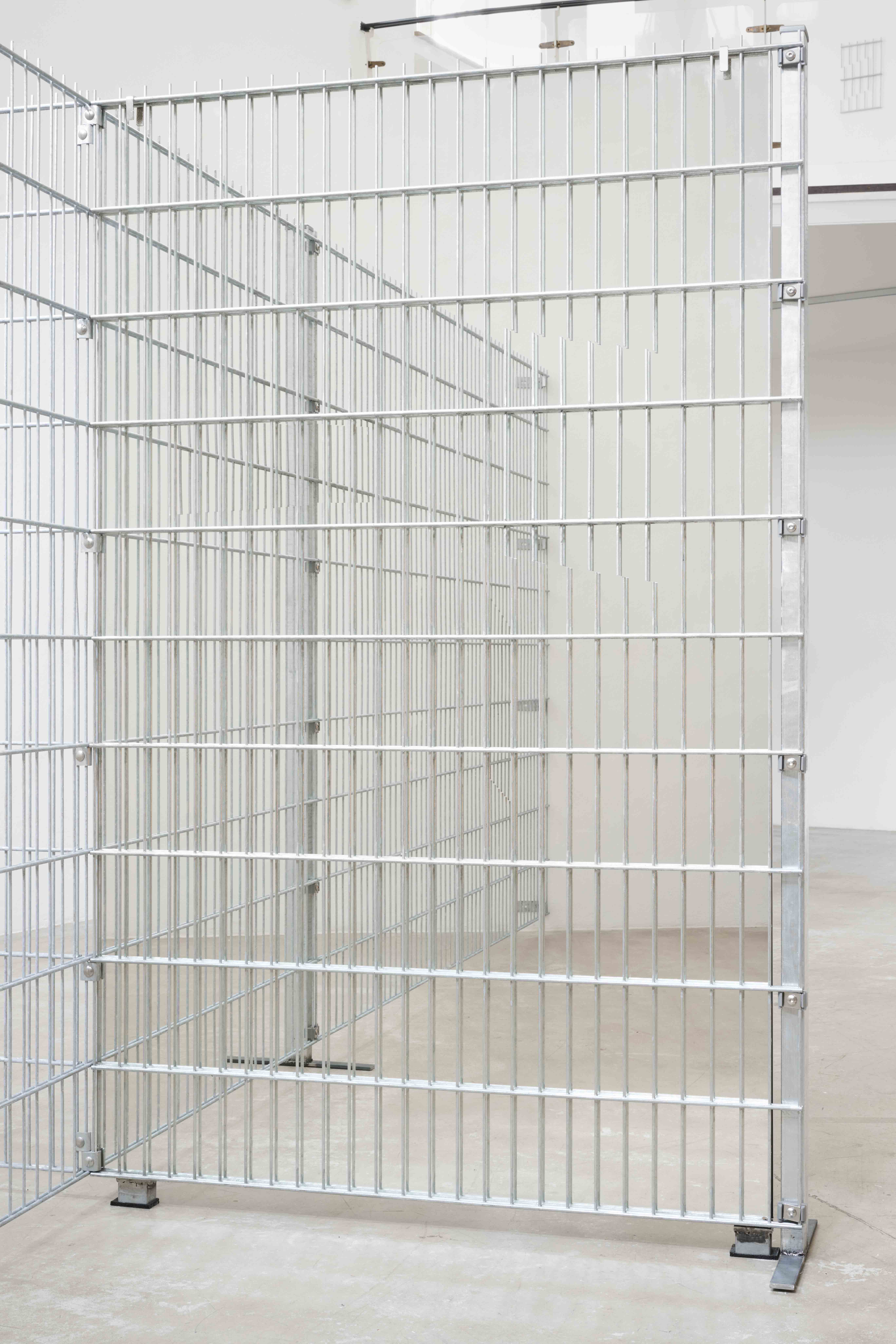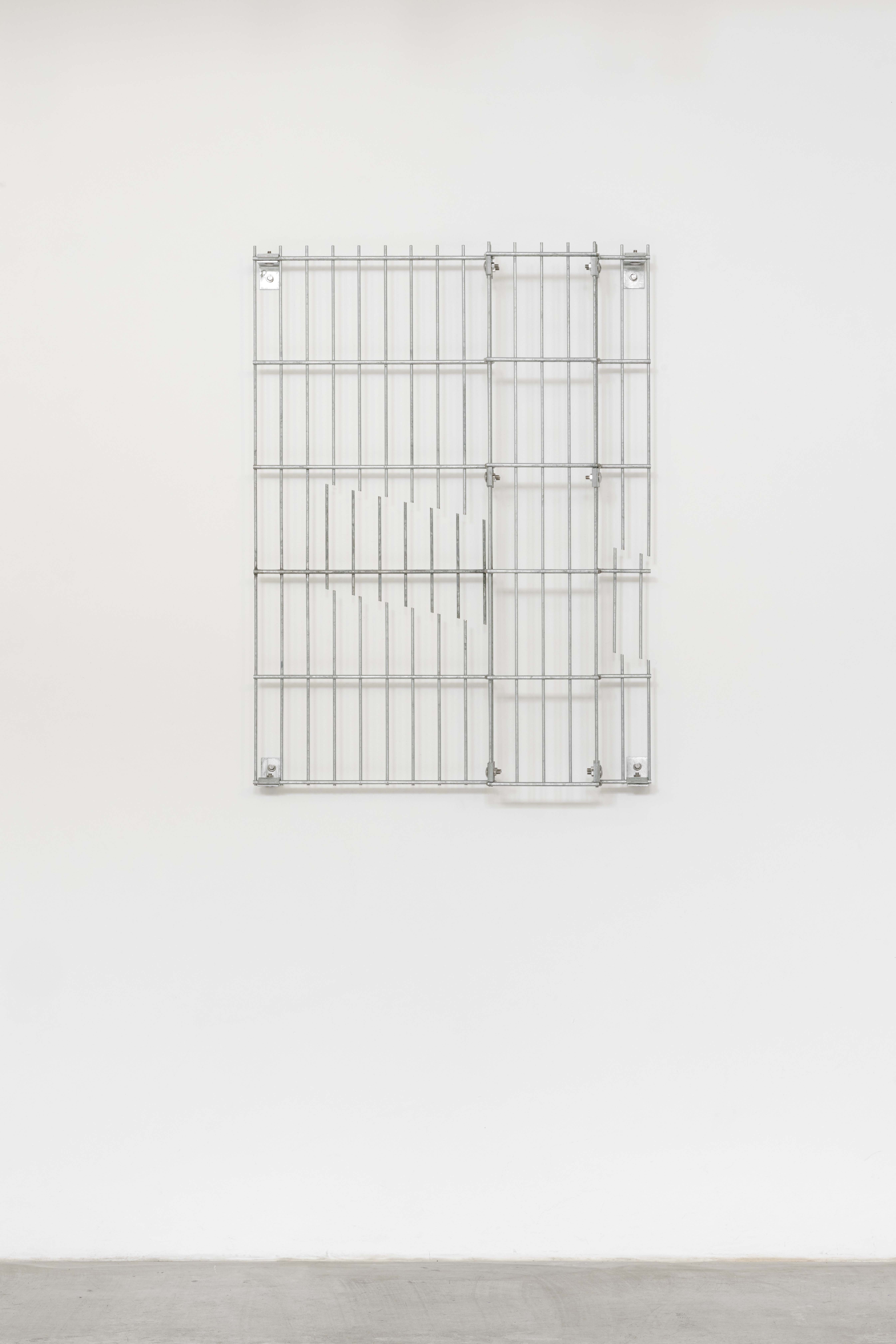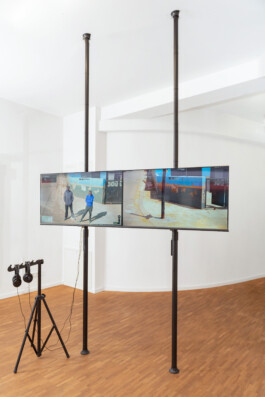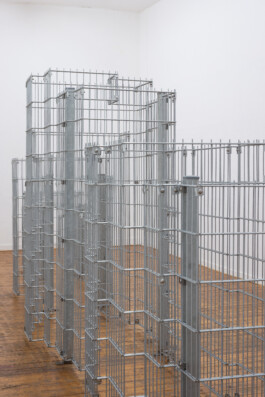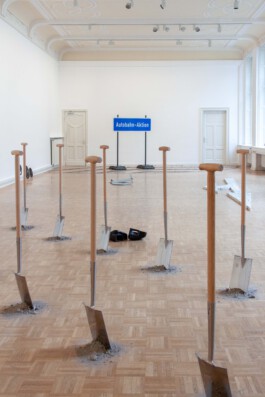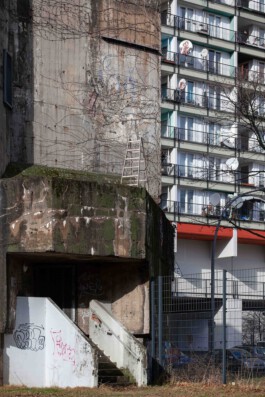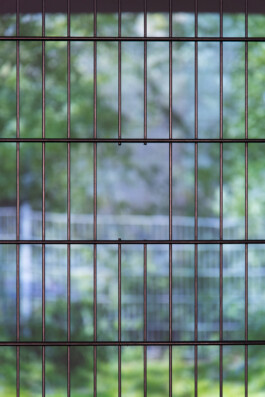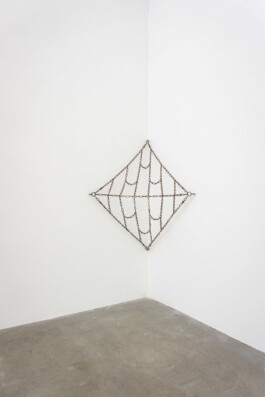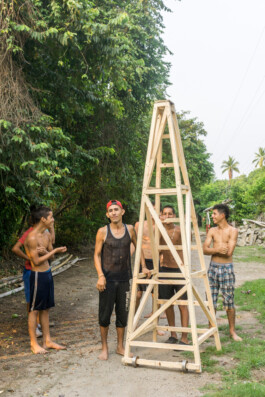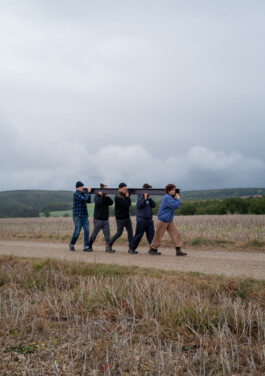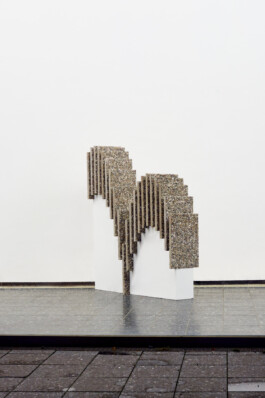
Waschbeton in Wallung
Bettina Bergstedt, März 2025, erschienen im Darmstädter Echo
Mathias Weinfurter ist in einer Hochhaussiedlung groß geworden. Vielleicht hat es den Künstler deshalb, außer in den musealen Raum der Rosen- und Mathildenhöhe, ganz besonders nach Kranichstein gezogen - von seinem Atelier in Arheilgen aus, das ihm als Charlotte-Prinz-Stipendiat zwei Jahre zur Verfügung steht, fußläufig erreichbar.
Es ist die viel geschmähte Architektur, die Weinfurter als Statement für Funktionalität fasziniert. Nach dem Zweiten Weltkrieg leisteten diese Wohnblocks angesichts der Wohnungsnot ihre Dienste: 1956 fehlten noch 23 Millionen Wohnungen...
Stören
Astrid Bardenheuer, Dezember 2024, erschienen in .22.23
Mathias Weinfurter ist der Friedrich-Vordemberge-Stipendiat für Bildende Kunst der Stadt Köln 2023. Als Preisträger entwickelt er für die artothek eine Ausstellung, die sich konzeptionell klar und trotzdem auch spielerisch mit Gestaltung und Funktion von Zäunen auseinandersetzt.
Der Zaun ist allgegenwärtiger Bestandteil unseres zivilisatorischen Alltags und in seinen Erscheinungsformen überwiegend funktional bestimmt. Er scheidet Staaten, Öffentliches von Privatem, grenzt ab und aus. schützt nach innen und außen und bringt eine klare Einteilung von diesseits und jenseits des Zaunes in den gesellschaftlich...
Die Störung im Allgegenwärtigen
Bettina Bergstedt, Dezember 2023, erschienen im Darmstädter Echo
Mathias Weinfurter ist erst ein paar Wochen in Darmstadt und weiß, dass er in seinem Arheilger Domizil genau zwei Jahre leben wird, dann zieht dort eine neue Charlotte-Prinz-Stipendiatin oder ein neuer Stipendiat ein. Das große Atelier mit offener Galerie zum Wohnbereich ist hoch, hell und geräumig mit Zugang und Blick in den Garten. Dass er hier mit Unterstützung der Stadt bis Ende 2025 arbeiten darf, empfindet Darmstadts neuer Charlotte-Prinz-Stipendiat als besondere Auszeichnung und als einen wichtigen Schritt in seiner Biografie.
Mit der Sicherheit des Stipendiums im Rücken kann er sich ausschließlich seiner Arbeit zuwenden…
Owners, Guests, and Trespassers
Sven Christian, June 2023, published by Villa-Legodi Centre for Sculpture
On Thursday, 15 December 2022, the Villa-Legodi Centre for Sculpture and NIROX hosted a webinar with Jeremy Wafer, Anna Boldt, and Mathias Weinfurter, moderated by Sven Christian. The webinar took place in the early stages of Boldt and Weinfurter’s residency at NIROX, and served as an introduction to Wafer’s work, who took up residence a few months later, on 16 May 2023, in preperation for an exhibition at Goodman Gallery that opens on 6 July 2023.
The webinar focused on land, mapping, surveillance, and the potential failures of photographic representation…
Im Käfig der Hochhaussiedlung
Julia Stellmann, März 2023, erschienen auf gallerytalk.net
Die Ankerstraße im nordrhein-westfälischen Sankt Augustin ist statistisch gesehen vom Rest der Gesellschaft abgehängt. Zugleich ist sie auch Heimatort des Künstlers selbst. In einer Ausstellung in der Kölner Moltkerei Werkstatt betreibt Mathias Weinfurter künstlerische Feldforschung, lotet die Abgründe in den Geometrien der Hochhaussiedlung aus und tatsächlich tun sich in Rastern wie Gitterstäben plötzlich Muster auf. Was, wenn sich die zugrundeliegende Machtstruktur ändern ließe, die qua Geburt gefangen nimmt?
Lichte Gitterstäbe, die Ausblick gewähren, deren Engstand jedoch gefangen macht...
Blick auf die Autobahn
Christine Dressler, April 2022, erschienen im Wiesbadener Kurier
Im Bellevue-Saal herrscht Verkehrschaos. Rund um den Spatenstich für die erste Reichsautobahn und Sabotageaktion dagegen verteilen sich Seitenspiegel, Auspuffrohre und Autofußmatten. Bis in den Stuck über der Eingangstür verschmelzen Lenkräder und Felgen miteinander. Zwischen der Baustelle und dem Schild "Autobahn-Aktion" verbietet ein Richtungspfeil, sich nach links zu wenden. Erlaubt nur, geradeaus zu fahren oder rechts abzubiegen. Mathias Weinfurter und Theresa Lawrenz' Ausstellung "130 km/h" regt schon durch den Titel dazu an, von der Geschwindigkeitsbegrenzung bis zur Elektromobilität über Lösungen für Verkehrs- und Umweltprobleme der Region nachzudenken...
Offenbach-neu
Elena Frickmann, October 2021, published in Offenbach-neu catalogue
Immerath. Etzweiler. Spenrath. Garzweiler. What these places have in common is the fact that they all no longer exist. They fell victim to lignite mining in the so-called Rhenish Lignite Mining Area, a triangle between Aachen, Cologne and Mönchengladbach. Where its residents once lived, the horizon now stretches into the deep. Looking into these opencast mining canyons is reminiscent of the Nothing from Michael Ende's novel “The Neverending Story”, which threatens to swallow up Fantasia while its inhabitants helplessly watch as their world and everything that lives in it gradually disappears. Another motif that runs through “The Neverending Story” is the relation between memory and identity, or rather their loss...
Status Quo Ladder - the poetry of a statement
Nils Altland, September 2021, published in ARCHIVE I
On a narrow ledge above the entrance to the Church of the Holy Sepulchre in Jerusalem, an inconspicuous wooden ladder leans against the wall. The oldest evidence of its existence is a woodcut from 1728 on which the ladder is depicted. But it may also have been there for much longer. No one knows for sure. The original function of the ladder is also not entirely clear: was it left there after work on one of the windows was done? Was it once used to enter the church when the gates were closed?
Only one thing is clear: the ladder must not be removed because it is part of the so-called Status Quo...
Fences: Between Order and Paradoxes
Marc Ries, September 2021, published in ARCHIVE I
On my usual route, I walk past a twin wire mesh fence. It separates a tennis court from the public green space that I use. I can see the players through it, but I cannot change sides. Certain activities presuppose their enclosure and demarcation. Their “being-other” requires a contraption that marks them as such and makes them inaccessible to those who are not part of them – part of this sport, for example – and part of the institution that enables their practice. Thus, according to a first interpretation, it is not private property that is separated from the public realm; rather, it is the division of activities themselves that determines this separation...
The ideological rechaining of freedom
Naomi Rado, September 2021, published in ARCHIVE I
Mathias Weinfurter borrows the title of his series of works P.P. from an everyday symbol of Italian-speaking areas. The abbreviation P.P. (proprietà privata) can be found on curbs, monuments, walls, gates and facades. Although P.P. does not refer to the initials of one specific person, it emphatically designates the property claims of individuals. Because, written out, P.P. unmistakably indicates private property. Similar to a nameplate on the cover of a book or on the door of an apartment, the stamp-like marking of space depries it of its common, i.e. public use...
A Colombian portrait with blurs
Peter Stohler, Yvan Sikiaridis, December 2020, published in Storytelling
Ambalema is a sleepy little town on the Rio Magdalena, about four hours west of the Colombian capital Bogotá. When looking for it on Google Maps, one sees a pattern of roads marked blue that can each be explored with Street View. In July 2013, a special vehicle of the Google corporation drove through Ambalema with an almost three-meter-high rack on top equipped with dome cameras taking photos. For reasons of data protection, a filter blurred all faces. The Latin America expert Anna Boldt (*1993) and Mathias Weinfurter (*1989), who studied at University of Art and Design in Offenbach, used these Street View images as the starting point of Miradas Borrosas (2019)...
Structures made of steel
Elena Frickmann, October 2020, published on KubaParis and ARCHIVE I
Jack London was not only known as a journalist and one of the most successful writers of his time, but also as an avowed socialist. In his essay What life means to me, the “born working class” reflects on his longing for social advancement, which began at an early age. He describes the structure of society as a building where he grew up in the basement. His goal is to reach the higher floors of the societal building. London believes that in finding a life more worth living, that he will know more selflessness, noble thinking and intellectual dominance...
Waschbeton in Wallung
Bettina Bergstedt, März 2025, erschienen im Darmstädter Echo
Mathias Weinfurter ist in einer Hochhaussiedlung groß geworden. Vielleicht hat es den Künstler deshalb, außer in den musealen Raum der Rosen- und Mathildenhöhe, ganz besonders nach Kranichstein gezogen - von seinem Atelier in Arheilgen aus, das ihm als Charlotte-Prinz-Stipendiat zwei Jahre zur Verfügung steht, fußläufig erreichbar.
Es ist die viel geschmähte Architektur, die Weinfurter als Statement für Funktionalität fasziniert. Nach dem Zweiten Weltkrieg leisteten diese Wohnblocks angesichts der Wohnungsnot ihre Dienste: 1956 fehlten noch 23 Millionen Wohnungen...

Stören
Astrid Bardenheuer, Dezember 2024, erschienen in .22.23
Mathias Weinfurter ist der Friedrich-Vordemberge-Stipendiat für Bildende Kunst der Stadt Köln 2023. Als Preisträger entwickelt er für die artothek eine Ausstellung, die sich konzeptionell klar und trotzdem auch spielerisch mit Gestaltung und Funktion von Zäunen auseinandersetzt.
Der Zaun ist allgegenwärtiger Bestandteil unseres zivilisatorischen Alltags und in seinen Erscheinungsformen überwiegend funktional bestimmt. Er scheidet Staaten, Öffentliches von Privatem, grenzt ab und aus. schützt nach innen und außen und bringt eine klare Einteilung von diesseits und jenseits des Zaunes in den gesellschaftlich...
Die Störung im Allgegenwärtigen
Bettina Bergstedt, Dezember 2023, erschienen im Darmstädter Echo
Mathias Weinfurter ist erst ein paar Wochen in Darmstadt und weiß, dass er in seinem Arheilger Domizil genau zwei Jahre leben wird, dann zieht dort eine neue Charlotte-Prinz-Stipendiatin oder ein neuer Stipendiat ein. Das große Atelier mit offener Galerie zum Wohnbereich ist hoch, hell und geräumig mit Zugang und Blick in den Garten. Dass er hier mit Unterstützung der Stadt bis Ende 2025 arbeiten darf, empfindet Darmstadts neuer Charlotte-Prinz-Stipendiat als besondere Auszeichnung und als einen wichtigen Schritt in seiner Biografie.
Mit der Sicherheit des Stipendiums im Rücken kann er sich ausschließlich seiner Arbeit zuwenden…
Owners, Guests, and Trespassers
Sven Christian, June 2023, published by Villa-Legodi Centre for Sculpture
On Thursday, 15 December 2022, the Villa-Legodi Centre for Sculpture and NIROX hosted a webinar with Jeremy Wafer, Anna Boldt, and Mathias Weinfurter, moderated by Sven Christian. The webinar took place in the early stages of Boldt and Weinfurter’s residency at NIROX, and served as an introduction to Wafer’s work, who took up residence a few months later, on 16 May 2023, in preperation for an exhibition at Goodman Gallery that opens on 6 July 2023.
The webinar focused on land, mapping, surveillance, and the potential failures of photographic representation. It included the screening of a short film by Boldt and Weinfurter, titled Miradas Borrosas (Blurry Gazes)…
Im Käfig der Hochhaussiedlung
Julia Stellmann, März 2023, erschienen auf gallerytalk.net
Die Ankerstraße im nordrhein-westfälischen Sankt Augustin ist statistisch gesehen vom Rest der Gesellschaft abgehängt. Zugleich ist sie auch Heimatort des Künstlers selbst. In einer Ausstellung in der Kölner Moltkerei Werkstatt betreibt Mathias Weinfurter künstlerische Feldforschung, lotet die Abgründe in den Geometrien der Hochhaussiedlung aus und tatsächlich tun sich in Rastern wie Gitterstäben plötzlich Muster auf. Was, wenn sich die zugrundeliegende Machtstruktur ändern ließe, die qua Geburt gefangen nimmt?
Lichte Gitterstäbe, die Ausblick gewähren, deren Engstand jedoch gefangen macht...
Blick auf die Autobahn
Christine Dressler, April 2022, erschienen im Wiesbadener Kurier
Im Bellevue-Saal herrscht Verkehrschaos. Rund um den Spatenstich für die erste Reichsautobahn und Sabotageaktion dagegen verteilen sich Seitenspiegel, Auspuffrohre und Autofußmatten. Bis in den Stuck über der Eingangstür verschmelzen Lenkräder und Felgen miteinander. Zwischen der Baustelle und dem Schild "Autobahn-Aktion" verbietet ein Richtungspfeil, sich nach links zu wenden. Erlaubt nur, geradeaus zu fahren oder rechts abzubiegen. Mathias Weinfurter und Theresa Lawrenz' Ausstellung "130 km/h" regt schon durch den Titel dazu an, von der Geschwindigkeitsbegrenzung bis zur Elektromobilität über Lösungen für Verkehrs- und Umweltprobleme der Region nachzudenken...
Offenbach-neu
Elena Frickmann, October 2021, published in Offenbach-neu catalogue
Immerath. Etzweiler. Spenrath. Garzweiler. What these places have in common is the fact that they all no longer exist. They fell victim to lignite mining in the so-called Rhenish Lignite Mining Area, a triangle between Aachen, Cologne and Mönchengladbach. Where its residents once lived, the horizon now stretches into the deep. Looking into these opencast mining canyons is reminiscent of the Nothing from Michael Ende's novel “The Neverending Story”, which threatens to swallow up Fantasia while its inhabitants helplessly watch as their world and everything that lives in it gradually disappears. Another motif that runs through “The Neverending Story” is the relation between memory and identity, or rather their loss...
Status Quo Ladder - the poetry of a statement
Nils Altland, September 2021, published in ARCHIVE I
On a narrow ledge above the entrance to the Church of the Holy Sepulchre in Jerusalem, an inconspicuous wooden ladder leans against the wall. The oldest evidence of its existence is a woodcut from 1728 on which the ladder is depicted. But it may also have been there for much longer. No one knows for sure. The original function of the ladder is also not entirely clear: was it left there after work on one of the windows was done? Was it once used to enter the church when the gates were closed?
Only one thing is clear: the ladder must not be removed because it is part of the so-called Status Quo...
Fences: Between Order and Paradoxes
Marc Ries, September 2021, published in ARCHIVE I
On my usual route, I walk past a twin wire mesh fence. It separates a tennis court from the public green space that I use. I can see the players through it, but I cannot change sides. Certain activities presuppose their enclosure and demarcation. Their “being-other” requires a contraption that marks them as such and makes them inaccessible to those who are not part of them – part of this sport, for example – and part of the institution that enables their practice. Thus, according to a first interpretation, it is not private property that is separated from the public realm; rather, it is the division of activities themselves that determines this separation...
The ideological rechaining of freedom
Naomi Rado, September 2021, published in ARCHIVE I
Mathias Weinfurter borrows the title of his series of works P.P. from an everyday symbol of Italian-speaking areas. The abbreviation P.P. (proprietà privata) can be found on curbs, monuments, walls, gates and facades. Although P.P. does not refer to the initials of one specific person, it emphatically designates the property claims of individuals. Because, written out, P.P. unmistakably indicates private property. Similar to a nameplate on the cover of a book or on the door of an apartment, the stamp-like marking of space depries it of its common, i.e. public use...
A Colombian portrait with blurs
Peter Stohler, Yvan Sikiaridis, December 2020, published in Storytelling
Ambalema is a sleepy little town on the Rio Magdalena, about four hours west of the Colombian capital Bogotá. When looking for it on Google Maps, one sees a pattern of roads marked blue that can each be explored with Street View. In July 2013, a special vehicle of the Google corporation drove through Ambalema with an almost three-meter-high rack on top equipped with dome cameras taking photos. For reasons of data protection, a filter blurred all faces. The Latin America expert Anna Boldt (*1993) and Mathias Weinfurter (*1989), who studied at University of Art and Design in Offenbach, used these Street View images as the starting point of Miradas Borrosas (2019)...
Structures made of steel
Elena Frickmann, October 2020, published on KubaParis and ARCHIVE I
Jack London was not only known as a journalist and one of the most successful writers of his time, but also as an avowed socialist. In his essay What life means to me, the “born working class” reflects on his longing for social advancement, which began at an early age. He describes the structure of society as a building where he grew up in the basement. His goal is to reach the higher floors of the societal building. London believes that in finding a life more worth living, that he will know more selflessness, noble thinking and intellectual dominance...
